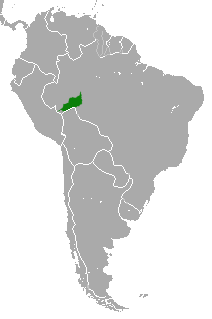
The Pitheciidae are one of the five families of New World monkeys now recognised. Formerly, they were included in the family Atelidae. The family includes the titis, saki monkeys and uakaris. Most species are native to the Amazon region of Brazil, with some being found from Colombia in the north to Bolivia in the south.
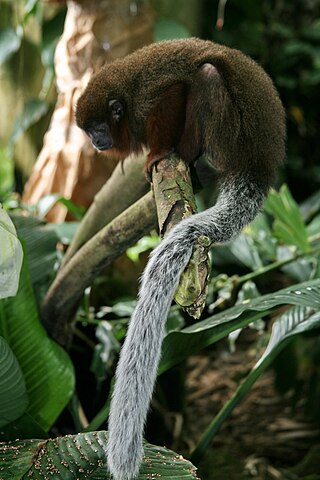
The titis, or titi monkeys, are New World monkeys of the subfamily Callicebinae, which contains three extant genera: Cheracebus, Callicebus, and Plecturocebus. This subfamily also contains the extinct genera Miocallicebus, Homunculus, and Carlocebus.
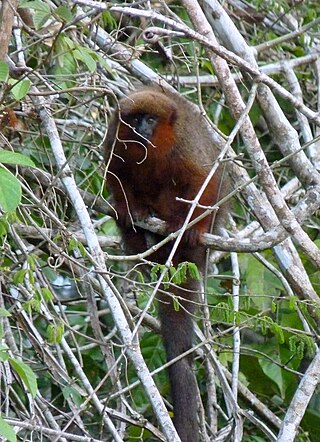
The Madidi titi monkey, also known as the GoldenPalace.com monkey or the golden palace monkey, is a titi, a kind of New World monkey, discovered in western Bolivia's Madidi National Park in 2004. Its scientific name is Plecturocebus aureipalatii, the specific epithet meaning "of the Golden Palace", in reference to GoldenPalace.com, an online casino which paid US$650,000 to have the species named after it, with benefits going toward the nonprofit organization that maintains the park where the titi was discovered.

The collared titi monkey is a species of titi, a type of New World monkey. It is endemic to northern Brazil.

The red-bellied titi monkey or dusky titi is a species of titi monkey, a type of New World monkey, endemic to Brazil. It lives in forests and thickets.

The white-eared titi monkey also known as the Bolivian titi or Bolivian gray titi, is a species of titi monkey, a type of New World monkey, from eastern Bolivia and an area of western Brazil. The species has a range that extends east from the Manique River in Beni Department, Bolivia to southern Rondônia in Brazil. The southern end of its range includes forests around the city of Santa Cruz de la Sierra.

The coppery titi monkey or red titi monkey is a species of titi monkey, a type of New World monkey, from South America. They are found in the Amazon of Brazil and Peru, and perhaps northern Bolivia. It was described as Callithrix cupreus in 1823. These monkeys have a lifespan of a little over 20 years. These monkeys eat certain fruits, insects, and plants. They live in monogamous pairs with interesting ways for vocalizing and protecting themselves from predators.
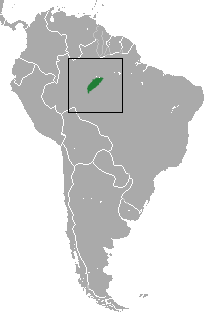
The chestnut-bellied titi monkey is a species of titi monkey, a type of New World monkey, endemic to Brazil. It was originally described as Callicebus caligatus in 1842.
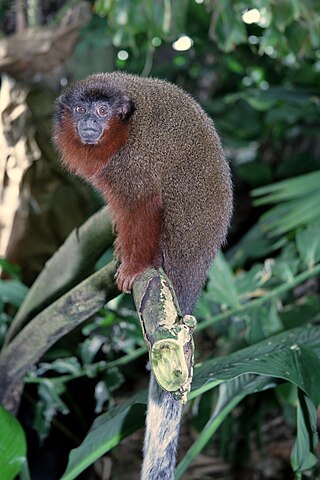
The brown titi monkey is a species of titi monkey, a type of New World monkey, from South America. It is endemic to Brazil. It was originally described as Callicebus brunneus in 1842 and transferred to the newly erected genus Plecturocebus in 2016.

Prince Bernhard's titi monkey, also called the zog-zog monkey, is a species of titi monkey in the genus Plecturocebus, first described in 2002. It is named after Prince Bernhard of the Netherlands. They have varying coloration of gray, black, and agouti, with dark orange in certain regions. They are endemic to Brazil, found mostly in disturbed forest environments. While officially listed as least-concern by the International Union for the Conservation of Nature (IUCN), they may, in fact, be at-risk due to human-caused deforestation.

The Baptista Lake titi monkey is a species of titi monkey, a type of New World monkey, endemic to Brazil. It was originally described as Callicebus baptista in 1939.

The white-tailed titi monkey is a species of titi monkey, a type of New World monkey, from South America. It is found in Colombia, Ecuador and Peru. It was described in 1848 as Callithrix discolor.
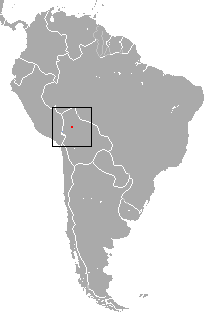
The Olalla brothers's titi monkey is a species of titi monkey, a type of New World monkey, endemic to Bolivia. There are between 110 and 150 individuals in the wild.
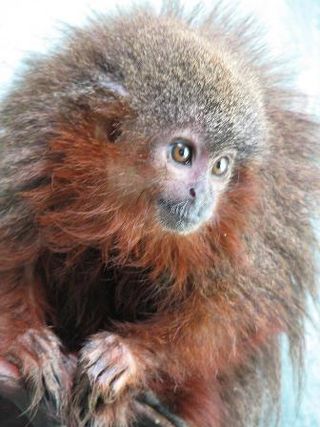
The Caquetá titi monkey, also known as the red-bearded titi or the bushy-bearded titi, is a species of titi monkey endemic to Colombia found in the Department of Caquetá region. Taxonomically, it is a member of the "Callicebus cupreus group", following Shunsuke Kobayashi's Callicebus grouping. It was first described by Thomas Defler, Marta Bueno and Javier Garcia in 2010. It is highly endangered due to habitat fragmentation and a small population.

Plecturocebus is one of three genera of titi monkeys.

The Alta Floresta titi monkey, also known as the Groves' titi monkey, is a species of titi monkey, a type of New World monkey, endemic to Brazil. It was described from the municipality of Alta Floresta in the state of Mato Grosso.

Toppin's titi monkey is a species of titi monkey, a type of New World monkey, from Brazil, Peru, and Bolivia.

The Urubamba brown titi monkey is a species of titi monkey, a type of New World monkey, endemic to Peru.
The Parecis titi monkey is a species of titi monkey, a type of New World monkey, endemic to Brazil.
